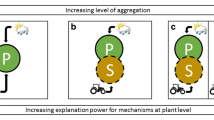Abstract
Large mammalian herbivores in grassland ecosystems influence plant growth dynamics in many ways, including the removal of plant biomass and the return of nutrients to the soil. A 10-week growth chamber experiment examined the responses of Sporobolus kentrophyllus from the heavily grazed short-grass plains of Serengeti National Park, Tanzania, to simulated grazing and varying nitrogen nutrition. Plants were subjected to two clipping treatments (clipped and unclipped) and five nitrogen levels (weekly applications at levels equivalent to 0, 1, 5, 10, and 40 g N m−2), the highest being equivalent to a urine hit. Tiller and stolon production were measured weekly. Total biomass at harvest was partitioned by plant organ and analyzed for nitrogen and mineral element composition. Tiller and stolon production reached a peak at 3–5 weeks in unclipped plants, then declined drastically, but tiller number increased continually in clipped plants; this differential effect was enhanced at higher N levels. Total plant production increased substantially with N supply, was dominated by aboveground production, and was similar in clipped and unclipped plants, except at high nitrogen levels where clipped plants produced more. Much of the standing biomass of unclipped plants was standing dead and stem; most of the standing biomass of clipped plants was live leaf with clipped plants having significantly more leaf than unclipped plants. However, leaf nitrogen was stimulated by clipping only in plants receiving levels of N application above 1 g N m−2 which corresponded to a tissue concentration of 2.5% N. Leaf N concentration was lower in unclipped plants and increased with level of N. Aboveground N and mineral concentrations were consistently greater than belowground levels and while clipping commonly promoted aboveground concentrations, it generally diminished those belowground. In general, clipped plants exhibited increased leaf elemental concentrations of K, P, and Mg. Concentrations of B, Ca, K, Mg, and Zn increased with the level of N. No evidence was found that the much greater growth associated with higher N levels diminished the concentration of any other nutrient and that clipping coupled with N fertilization increased the total mineral content available in leaf tissue. The results suggest that plants can (1) compensate for leaf removal, but only when N is above a critical point (tissue [N] 2.8%) and (2) grazing coupled with N fertilization can increase the quality and quantity of tissue available for herbivore removal.
Similar content being viewed by others
Author information
Authors and Affiliations
Additional information
Received: 25 August 1997 / Accepted: 14 April 1998
Rights and permissions
About this article
Cite this article
Hamilton III, E., Giovannini, M., Moses, S. et al. Biomass and mineral element responses of a Serengeti short-grass species to nitrogen supply and defoliation: compensation requires a critical [N]. Oecologia 116, 407–418 (1998). https://doi.org/10.1007/s004420050604
Issue Date:
DOI: https://doi.org/10.1007/s004420050604




